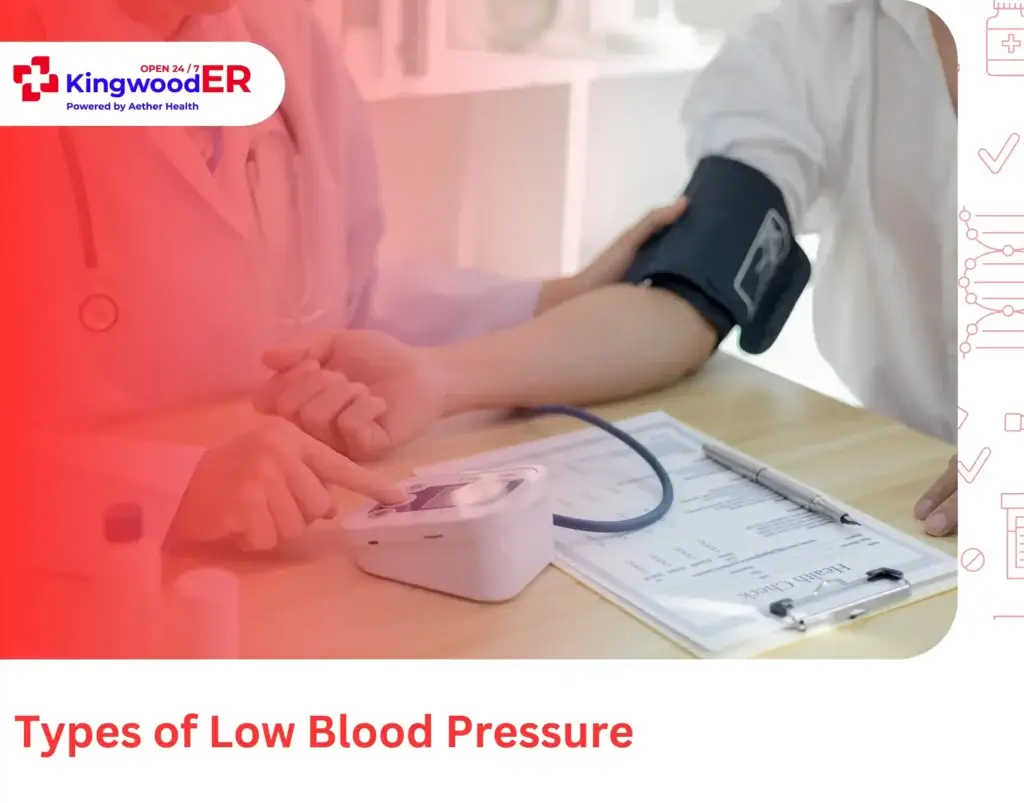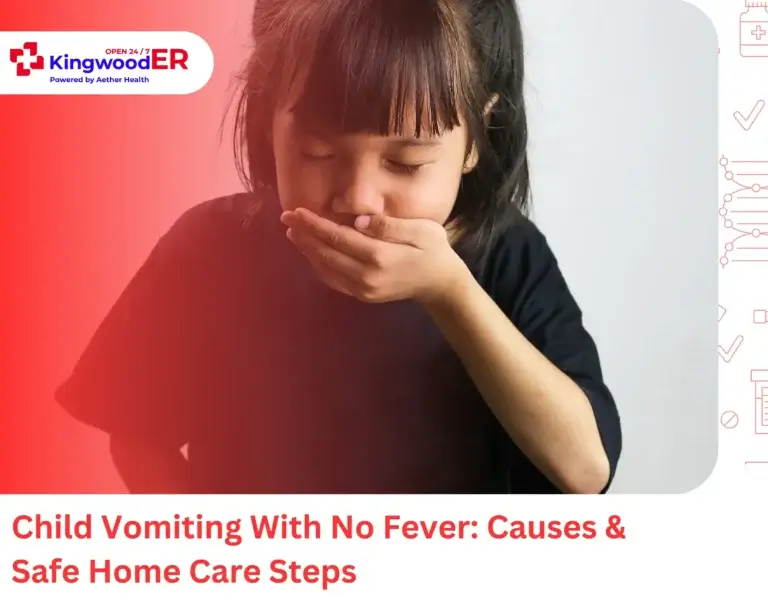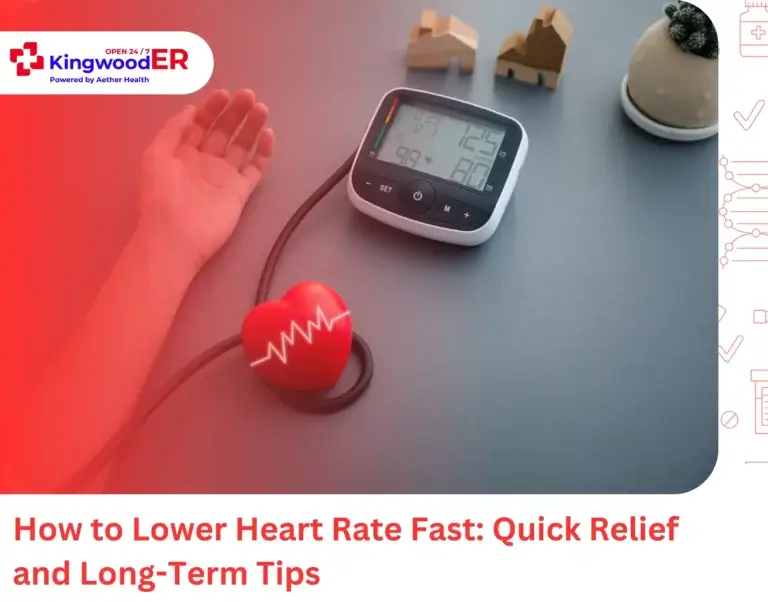Do you sometimes feel lightheaded, experience blurred vision, or suddenly feel weak and unsteady? These are classic warning signs that your blood pressure may be dropping to dangerous levels. While sitting down and staying hydrated can help in the moment, frequent episodes require medical evaluation.
If you’re experiencing these episodes regularly, understanding what causes low blood pressure becomes crucial for your health. While often less concerning than high blood pressure, hypotension can lead to serious complications including dizziness, fainting, and even shock.
At Kingwood ER, we regularly meet patients who didn’t realize their symptoms were related to an underlying cause of hypotension. So, let’s walk you through both common and surprising causes of low blood pressure, and when these symptoms warrant immediate medical attention.
Causes of Low Blood Pressure

Low blood pressure occurs when your systolic blood pressure drops below 90 mmHg or your diastolic reading falls below 60 mmHg. Let’s explore 5 causes to help you determine whether your low blood pressure needs immediate attention.
1. Impaired Cardiac Output
One of the common causes of low blood pressure is cardiac dysfunction. This includes bradycardia (slow heart rate), heart failure, and heart valves problems. These conditions reduce blood flow throughout your body, causing pressure to drop. When your heart can’t pump efficiently, less blood reaches your organs and tissues.
2. Blood Loss and Dehydration
Hypovolemic shock (reduced blood volume) is another common cause of hypotension. Trauma, gastrointestinal bleeding, or surgical complications can result in acute blood loss, which reduces blood pressure. Dehydration from vomiting, diarrhea, or not drinking enough fluids has a similar effect. According to the CDC, dehydration contributes to more than 500,000 ER visits annually.
3. Adrenal Insufficiency
Addison’s disease prevents your adrenal glands from producing enough cortisol and aldosterone. These are hormones that help maintain normal blood pressure by regulating fluid balance. Cortisol also helps your heart pump effectively. When these hormone levels drop significantly, blood pressure often follows, leading to chronic hypotension that requires ongoing management.
4. Diabetes
Uncontrolled diabetes can damage nerves that help regulate blood pressure, making it harder for your body to maintain normal levels. Both Type 1 and Type 2 diabetes can affect how your heart and blood vessels function over time.
5. Thyroid Disorders
Thyroid disorders also impact blood pressure regulation. An underactive thyroid (hypothyroidism) slows your heart rate, reducing the amount of blood your heart pumps. An overactive thyroid (hyperthyroidism), on the other hand, causes blood vessels to widen and changes how blood flows through your body, both of which can lower blood pressure.
Types of Low Blood Pressure

Let’s now explore the types of low blood pressure depending on their underlying cause.
1. Orthostatic Hypotension (Postural Hypotension)
Orthostatic hypotension occurs when systolic and diastolic blood pressure drops by 20 mmHg and 10 mmHg within 3 minutes of standing up from a sitting position. This condition is more common in older adults because the body’s blood pressure regulation system becomes less responsive with age. The patient often feels dizzy or lightheaded when standing up after sitting or lying down.
2. Postprandial Hypotension
Postprandial hypotension is related to a drop in blood pressure within 75 minutes of having a meal. This result is specific to carbohydrate-rich meals, as they are difficult to digest, so most of the blood goes to the intestine to help absorption.
3. Shock-Related Hypotension
Another reason for low blood pressure is shock, a critical condition where blood pressure drops significantly due to inadequate blood flow. This leads to organs not working properly since they are not getting enough oxygen. Shock can develop from several different causes, each affecting blood pressure in distinct ways.
- Septic Shock: This happens when your body has a severe infection.
- Anaphylactic Shock: This is a severe allergic reaction, like from a bee sting or certain foods.
- Cardiogenic Shock: It occurs when the heart cannot pump enough blood, often because of a heart attack.
- Hypovolemic Shock: It occurs when you lose a large amount of blood or body fluids, often more than 30% of the total blood volume.
- Obstructive Shock: This type of shock occurs due to a physical blockage that stops the heart from filling properly, such as a blood clot in the lungs.
4. Neurally Mediated Hypotension (Vasovagal Syncope)
Vasovagal syncope occurs when your nervous system overreacts to certain triggers, causing your heart rate and blood pressure to drop suddenly. It’s common in young adults and children, and occurs after standing still for long or following emotional strain. Clinical markers of NMH include pale skin, sweating, and nausea that precede fainting.
5. Medication-Induced Hypotension
Many common medications can cause low blood pressure as a side effect. These include:
- Diuretics
- ACE inhibitors
- Beta blockers
- Calcium channel blockers
- Opioids
- Muscle relaxants
Sign and Symptoms of Low Blood Pressure

Low blood pressure does not always show noticeable symptoms. But when it does, it’s because of inadequate blood flow to the heart and brain. Some common symptoms include:
- Dizziness
- Fainting
- Blurred vision
- Fatigue
- Pale skin
- Nausea
- Slow heart rate
These symptoms often improve by sitting or lying down to restore blood flow. If you’re experiencing these symptoms repeatedly, we recommend checking your blood pressure promptly.
How to Manage and Live with Hypotension
Managing low blood pressure, or hypotension, requires lifestyle changes, diet, and sometimes medication to avoid symptoms and potential complications. Here’s how you can do that:
- Drink Plenty of Water: Taking proper fluid intake prevents dehydration, a common cause of hypotension.
- Reduce Intake of Alcoholic Beverages: Avoid alcohol at any cost, as it can dehydrate your body, which aggravates the symptoms.
- Increase Consumption of Electrolytes: Electrolyte solutions (salt + sugar) can help restore blood pressure to normal by maintaining the fluid balance in the bloodstream.
- Frequent Smaller Meals over Larger Meals: Smaller and more frequent meals help avoid sudden blood pressure drops, leading to a lower insulin release into the bloodstream.
- Use Compression Stockings: Elastic compression stockings improve circulation while reducing blood pooling in the legs.
- Change Positions Slowly: Do not sit or stand up quickly. Slow actions permit the cardiovascular system to cope, which reduces the risk of dizziness and fainting.
- Exercise Regularly: Incorporate slight activities into your routine, such as swimming, cycling, jogging, etc.
- Take Proper Diet: Include nutrients and supplements such as vitamin B12, folate, and iron in your diet.
When to Seek Help for Low Blood Pressure
Most cases of low blood pressure don’t require emergency treatment, but certain symptoms demand immediate medical attention. Understanding what causes low blood pressure helps you recognize when it’s time to seek care.
Seek emergency care immediately if you experience:
- Chest pain or difficulty breathing
- Severe dizziness with loss of consciousness
- Rapid, weak pulse with confusion
- Signs of shock (cold, clammy skin, rapid breathing)
Schedule routine medical evaluation for:
- Frequent dizzy spells when standing
- Persistent fatigue affecting daily activities
- New symptoms after starting medications
- Blood pressure readings consistently below 90/60 mmHg
Kingwood ER provides 24/7 evaluation for serious hypotension symptoms. Our emergency physicians can quickly identify whether your low blood pressure indicates a medical emergency or requires ongoing management with your primary care provider.




